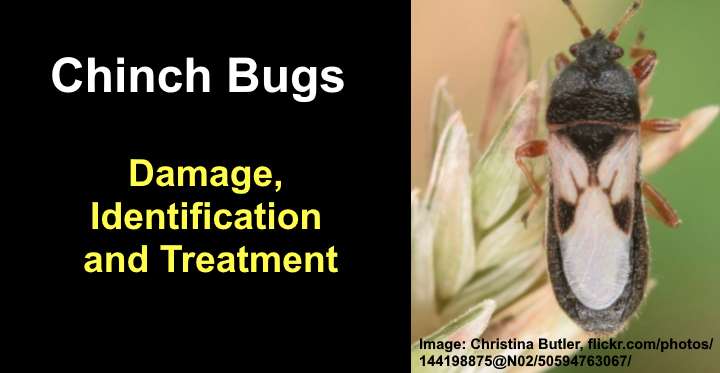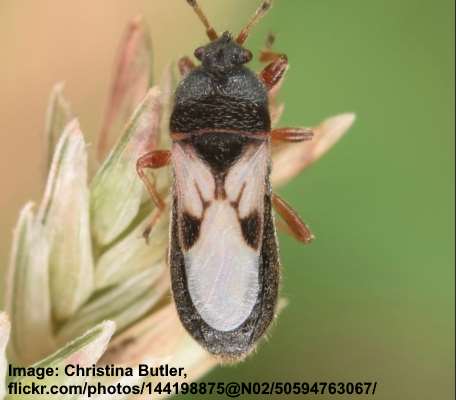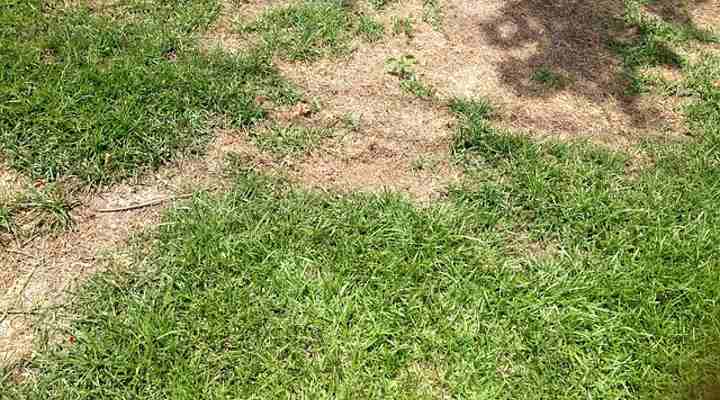Chinch Bugs: Damage, Identification and Treatment (With Pictures)

Chinch bugs are common destructive yard pests that damage lawns. Chinch bug damage can appear as dead patches of turfgrass as if it’s suffered from sun scorch. However, the real culprit can be tiny brown or black bugs with a large white spot on their wing covers. These lawn pests in the turfgrass thatch feed on grass, thriving in hot, dry environments.
Chinch bug damage can be difficult to repair once brown patches appear on lawns. In most cases, you must reseed your lawn, remove any thatch on existing turfgrass, and keep it well-watered. This essential lawn care helps to prevent chinch bugs from returning and causing more damage the following year.
The best way to stop chinch bugs from destroying your lawn is to prevent them in the first place. However, you must also know how to check your lawn for chinch bug activity. This is because the chinch bug damage can resemble other issues with lawn health.
This article is a complete guide to identifying chinch bugs and eradicating them from your yard. You’ll also find helpful tips on repairing chinch bug damage on your lawn.
What is a Chinch Bug?

Hairy chinch bug (Blissus leucopterus hirtus)
A chinch bug is a tiny insect that is a notorious pest of lawn grass. Chinch bugs are classified as true bugs in the order Hemiptera. Chinch bugs bite with their sucking mouthparts to pierce plant tissue and suck the juices. This causes grass to rot and die, typically turning brown.
Adult chinch bugs appear dark brown or black and have creamy-white or silvery patches on their wings. Some species of chinch bugs are also covered in fine, short hairs, giving them a fuzzy appearance when viewed up close. Hairy chinch bugs are typically less than 0.25” (6 mm) long.
There are two primary species of chinch bugs in North America. These are the:
Hairy chinch bug (Blissus leucopterus hirtus): This grass-destroying bug measures 0.16” (4 mm) long and is dark red to brown, and has distinctive white wings. The hairy chinch bug has a preference for Kentucky bluegrass, fescues, and perennial ryegrass.
Southern chinch bug (Blissus insularis Barber): This lawn pest has a black body with white wings and black markings on the wing margins. The southern chinch bug grows up to 0.25” (6 mm) long. A common pest that can infest various types of turfgrasses.
Chinch Bug Damage
Plant and grass damage from chinch bugs happens when the pesky insects bite into roots and plant tissue. Chinch bug damage to grass occurs as they suck plant juices, weakening the grasses. The nasty bugs also transmit pathogens and digestive enzymes that infect and kill grass at the roots.
Chinch bugs don’t just damage turfgrass and ornamental grasses. The juice-sucking bugs also attack wheat, barley, corn, rye, oats, sorghum, and millet. The resulting bug damage from their activity causes stunted growth, wilting, and yellowing foliage. The bugs are more active in dry weather, where they infest all types of plants in the grass family.
How Chinch Bugs Damage Lawns
Lawn damage is one of the most common signs of chinch bug activity. The bugs live in lawns in the layer of grass, dead leaves, and roots called thatch. The bugs are active around the soil level and bite into grass blades. Apart from sucking the grass juices, they also inject a toxin that kills grass.
When chinch bugs have sucked the life out of the grass blades, and they are dry, they then move on to fresh grass, extending the scope of their damage. So in lawns with heavy infestations, you may see the grass-destroying bugs scurrying over grass blades to inflict damage to other parts of the yard.
Signs of Chinch Bug Damage in Lawns

Chinch bug damage looks like irregular patches of dead grass
The most common sign of chinch bug damage is patches of lawn that turn brown and die. However, the classic symptom of chinch bugs is not widespread damage. It looks more like scattered patches of wilted grass. As the blades of grass die, they change from green to pale yellow and eventually a reddish brown.
Chinch bug damage to the lawn looks like the grass has been affected by drought conditions. And because chinch bugs are more active during hot, arid weather, it could be easy to mistake the lawn damage as a lack of moisture in the soil.
Chinch Bug Life Cycle
The life cycle of a chinch bug starts as a tiny, pale white oval egg that turns red before it hatches. After 20 to 30 days, the eggs hatch, and nymphs start feeding on grass. At this stage, they are reddish brown with a white stripe across their abdomens.
It takes four to six weeks for chinch bugs to mature after hatching. They then mate, and the adult females lay more eggs in grass thatch. The female can lay up to four eggs daily and 250 in her lifetime.
When the weather becomes cooler in fall, adult chinch bugs seek refuge in the roots and base of turfgrass. Then, when temperatures rise, the adults emerge in the spring, and the life cycle continues, along with more damage to your lawn.
How to Look for Chinch Bug Damage in Lawns
It is vital to investigate chinch bug damage if you notice bare brown patches of lawn. It’s easy to mistake chinch bug activity for other lawn issues like dehydration, lawn grub infestations, root rot, and other diseases. However, if you keep your lawn well maintained and still have brown patches, you should check for chinch bugs.
The first step to checking your lawn for chinch bug activity is carefully looking for them. To spot the bugs, you’ll need to get down on your hands and knees and separate the blades of grass. Next, look just above the soil line for the tiny bugs moving around.
You may also notice immature bugs and winged adult chinch bugs. The adults are typically black and white, whereas the nymphs are usually orange, red, or dark brown and have a white band across their abdomen.
The best place to look for chinch bugs is at the edge of the brown patches, just where the unhealthy part of your lawn meets healthy green turfgrass.
The tin can method to check lawns for chinch bug activity
Do you suspect chinch bugs are taking over your lawn? If so, the tin can method is a tried and trusted way of telling if chinch bugs are infesting your prized turfgrass.
Also called the flotation method, here is how to tell if chinch bugs are to blame for lawn damage.
First, put on a pair of gardening gloves to protect your hands. Then cut the top and bottom off a large metal can and insert it into the soil surrounding the discolored grass about 3” (7.5 cm) deep. Using a garden hose, gently fill the hole with water, and keep filling for around five minutes.
Chinch bugs will drown in the water and float to the top. If you confirm chinch bug activity, you can take steps to eradicate them from the grass.
But suppose you don’t have a large metal can to identify the chinch bugs. In that case, you can dig out a piece of damaged turf together with a healthy patch. This is because chinch bugs are always on the move to feed on new grass. Next, put the turf in a bucket of water. If you have a chinch bug problem, you’ll notice the critters floating on the top of the water.
Chinch Bug Identification
Identifying chinch bugs is the first step in eradicating them. This is because you must use the proper control methods if you want to prevent the nasty critters from causing more damage to your lawn. The issue with chinch bug identification is that they are so tiny.
Immature chinch bugs are usually orange to bright red and measure about 0.08” (2 mm) long. They have an identifiable band on their abdomen. Adult chinch bugs are about the size of a grain of rice. They are identified by their black and white wings and orange legs.
When Do Chinch Bugs Appear?
Chinch bugs emerge from lawn thatch in late spring or early summer when the weather becomes warmer. As the temperature rises, they become more active and can produce hundreds of offspring. Adult females lay eggs in midsummer, which will then hatch after a few weeks. This means that adult chinch bugs live alongside nymphs.
Chinch Bug Prevention
The best way to prevent chinch bug damage is to keep your lawn healthy and well maintained. Chinch bugs are attracted to a heavily thatched lawn that is stressed. Additionally, dry soil and hot weather only encourage a rampant chinch bug population explosion.
Here are three recommended ways to prevent chinch bugs in your lawn:
Dethatch your lawn to prevent chinch bugs
Remove excess thatch from turfgrass to promote healthy grass growth. Thatch is a buildup of dead leaves and other organic matter that builds up at the soil line. This layer creates the ideal environment for chinch bugs to live. In addition, thatch stresses lawns by preventing water, nutrients, and oxygen from getting to the roots.
Dethatching lawns in late summer also helps prevent chinch bug eggs from developing. In addition, removing thatch is beneficial for lawn health in general. At the same time, aerate your lawn to help boost its health and promote resistance to chinch bug activity.
Prevent chinch bugs by mowing your lawn
Regularly mowing your lawn to the recommended height for the type of turfgrass is crucial in your battle with chinch bugs. Not letting turfgrass be too short or too long helps promote healthy growth because enough sunlight gets to the roots. This also helps lock in moisture and regulate soil temperature.
Remember that chinch bugs love it when the ground gets hot and dry. So by keeping the grass blade length at the right level and the soil moist, you disrupt their habitat. As a result, they will not reproduce as rapidly, and their activity will diminish.
Proper lawn irrigation is crucial for chinch bug prevention
A healthy, lush, green lawn free from chinch bugs depends on keeping the ground well irrigated. Healthy grass is more resistant to pest activity, including chinch bugs. In addition, dousing your lawn with water can also result in the nymphs drowning.
How to Get Rid of Chinch Bugs From Lawns
Good lawn management and appropriate lawn fertilization are the best ways to rid your lawn of chinch bugs. However, it’s crucial to ensure that your lawn care techniques are correct. The last thing you want is to encourage uncontrolled chinch bug activity.
Lawn fertilization to eliminate chinch bugs: Use proper fertilization practices to keep your lawn healthy. This promotes healthy grass that is resistant to bug damage. Therefore, you should avoid overfertilizing the grass. Too much nitrogen can boost chinch bug numbers and weaken turfgrass health.
Encourage beneficial insects to control chinch bugs: Not all bugs are harmful to your lawn. And there are several chinch bug predators that can help control their numbers. For example, you can encourage beneficial insects like ground beetles, big-eyed bugs (Geocoris uliginosus), parasitoid wasps (Eumicrosoma benefica), and earwigs.
Chinch Bug Treatment
Despite caring for a lawn, chinch bugs can still be a nuisance in some yards. You may continue to see irregular patches of lawn that look brown and patchy. Then, lawn weeds may start growing in the brown lawn areas, spoiling the look of your lush turf grass.
When treating a chinch bug infestation in gardens, flower beds, vegetable patches, and lawns, it’s always best to try natural organic remedies first. These natural pesticides don’t pollute the soil with chemicals and help prevent resistance.
You could try a neem oil treatment to rid your lawn of grass-damaging chinch bugs. First, make a neem oil spray by mixing four teaspoons of organic neem oil for every gallon (3.4 l) of water. However, if the infestation is particularly bad, you could increase the amount to 2 fl. oz. (57 ml) per gallon.
Then treat the affected lawn areas where chinch bugs have been active. You can do this by pouring or spraying the neem oil treatment on the lawn to thoroughly saturate the soil. Apply the treatment every seven days for the best results.
Here is a list of some organic chinch bug treatments you can try to get rid of chinch bugs for good:
- EcoSMART Insect Killer Granules to eliminate all unwanted pests from lawns.
- Safer Soap helps to destroy the outer shell of chinch bugs and other pesky insects.
- BotaniGard ES contains Beauveria bassiana — a type of fungus that acts as a natural insecticide.
How to Restore a Lawn After Chinch Bug Damage
After getting rid of the chinch bugs from your lawn, you will need to work on restoring your lawn to its former lushness. Re-establishing your lawn will help to keep it healthy and eliminate any brown patches caused by a chinch bug infestation.
Late summer or early spring is the best time to re-establish a healthy lawn. The first step is to remove as much dead matter as possible from the affected areas. Then, you should reseed the affected area using the right mix of turfgrasses for your growing zone and sun exposure.
If you have Kentucky bluegrass, it’s best to ensure there is less than 50 percent in the mix because this only attracts chinch bugs.
Once your lawn starts thriving again, and there is no evidence of chinch bug activity, you will need to ensure good lawn care practices. These include the following:
- Testing the soil to ensure it has the correct level of nutrients
- Mowing the lawn to the appropriate height
- Aerating and removing thatch from the lawn every few years
- Keeping the right level of soil moisture in the ground
Related articles:
- How to Get Rid of Grubs In Lawn
- Organic Lawn Care: How to Maintain Your Lawn Naturally
- Different Types of Lawn Grass
